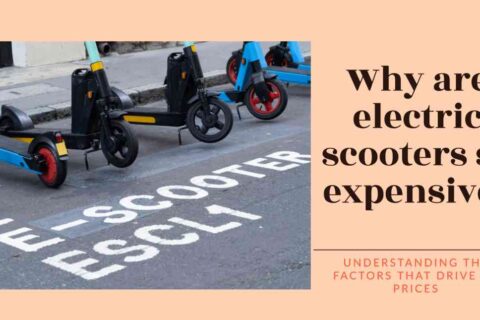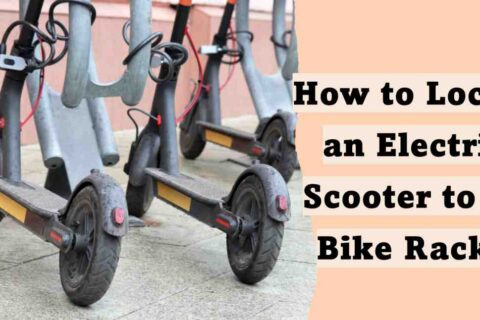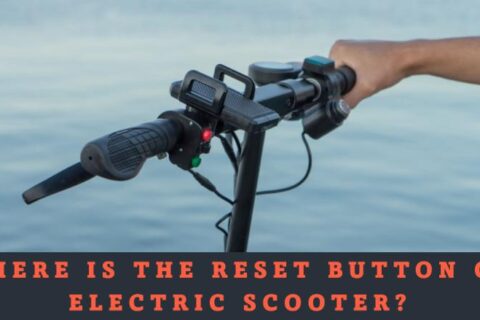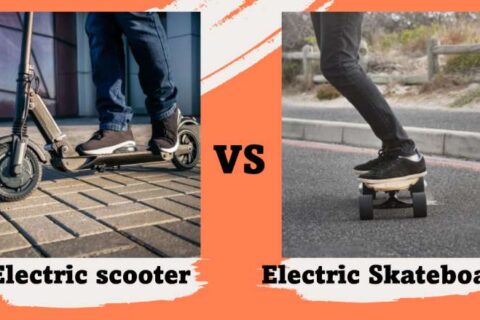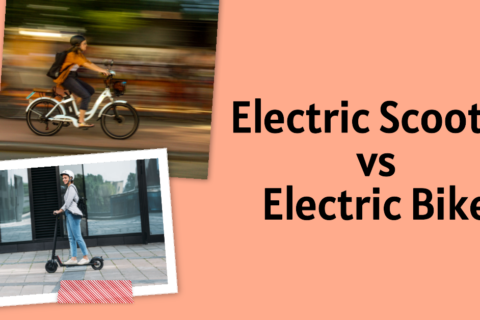Winter has arrived, and as the temperature drops, it’s time to think about How to Store Electric Scooter in Winter properly.
Just like any other vehicle, electric scooters require special care during the cold season to ensure they remain in optimal condition. Here we’ll explore the best practices for storing your electric scooter in winter, so it’s ready to hit the road when the sun returns.
Key Takeaway:
- Winterize your electric scooter by cleaning, inspecting, and charging it before storage.
- Choose a sheltered location or use a waterproof cover to protect it from the elements.
- Regularly check the scooter during storage for moisture and condensation.
- Prioritize safety and avoid riding in harsh winter conditions.
- Prepare for spring by reassembling and checking the scooter’s components.
Table of Contents
ToggleUnderstanding the Impact of Winter on Electric Scooters
Before we dive into the storage tips, let’s first understand how winter can affect your electric scooter. The combination of low temperatures, icy roads, and moisture can take a toll on various components of your ride.
The battery performance may decrease in the cold, and the rubber tires might lose traction, making it challenging to ride safely.
Taking the right precautions can shield your electric scooter from potential damage and prolong its lifespan.

Preparation of How to Store Electric Scooter in Winter
Before you tuck your electric scooter away for winter, there are essential steps to follow to ensure it stays in top shape. Let’s dive into the process of winterizing your electric scooter with an easy-to-follow checklist.
- Thorough Cleaning: Start by giving your electric scooter a thorough cleaning. Wash away any dirt, mud, or grime that may have accumulated during your adventures. A clean scooter is less likely to suffer from corrosion and will look better when you take it out of storage.
- Inspect and Repair: Carefully inspect your electric scooter for any signs of wear and tear. Check the tires, brakes, lights, and all other parts for damage. Address any issues or repairs before storing it away to avoid worsening the problems during winter.
- Charge the Battery: Fully charge your scooter’s battery before storing it. A charged battery is less likely to freeze in cold temperatures. For added protection, store the battery indoors in a cool, dry place, away from extreme cold.
- Battery Maintenance: If you plan to store your electric scooter for an extended period, consider partially charging the battery every few weeks to prevent complete discharge. A completely discharged battery can be difficult to revive, so periodic maintenance is essential.
- Remove the Battery (if applicable): If your scooter allows it, consider removing the battery during storage and storing it separately. This prevents any potential energy loss and keeps the battery in better condition.
- Protective Cover: Invest in a high-quality scooter cover that fits your model snugly. A waterproof cover will protect your ride from rain, snow, and debris, ensuring it remains in excellent condition.
Battery Protection During Winter Storage
The battery is the lifeblood of your electric scooter, and it requires special attention during the winter season. Cold temperatures can have a significant impact on battery performance, potentially affecting its longevity and overall health.
- Fully Charge the Battery: Before storing your electric scooter for winter, ensure that the battery is fully charged. A charged battery is less likely to freeze and will maintain its overall health during the storage period.
- Store in a Cool, Dry Place: Find a sheltered storage location with a cool and dry environment. Extreme cold or heat can damage the battery, so keeping it in a stable temperature range is essential.
- Remove the Battery (if possible): If your electric scooter allows for easy battery removal, consider taking it out during winter storage. Storing the battery separately in a temperature-controlled space can help preserve its charge and extend its life.
- Avoid Extreme Temperatures: As mentioned earlier, extreme temperatures can harm the battery. Avoid leaving your electric scooter in freezing conditions for extended periods.
- Charge the Battery Periodically: If you choose to leave the battery in the scooter during storage, check it periodically, and recharge it as needed. Batteries can self-discharge over time, and keeping them partially charged during winter prevents complete discharge.
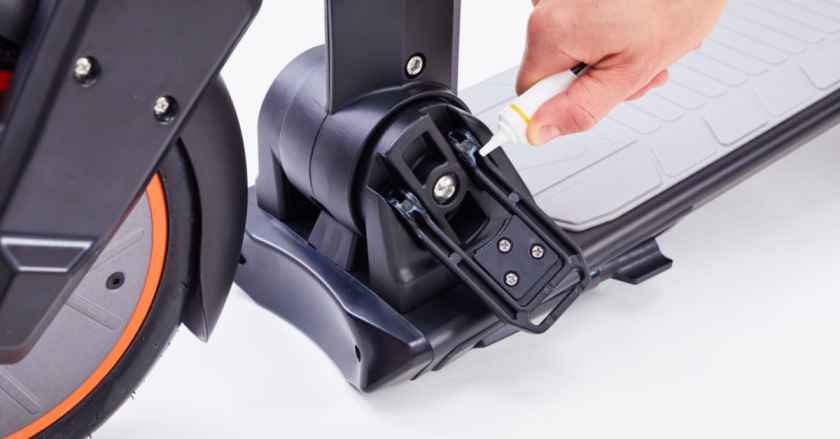
Checking and Lubricating Moving Parts
1. Inspecting the Wheels and Bearings:
Begin by inspecting the wheels of your electric scooter. Check for any visible signs of wear and tear, such as cracks, flat spots, or uneven tread. If your scooter has pneumatic tires, ensure they are adequately inflated to the recommended pressure. Proper tire pressure is essential for maintaining stability and traction.
Next, pay attention to the wheel bearings. These small components allow the wheels to spin freely and smoothly. Over time, dirt, moisture, and debris can accumulate in the bearings, leading to increased friction and potential damage.
2. Checking the Brakes:
Before storing your scooter for winter, check the brake pads for wear. Worn-out brake pads might compromise your ability to stop safely when you ride again in the spring. Replace any brake pads that have reached their minimum thickness.
Also, inspect the brake cables for signs of fraying or damage. If you notice any issues, it’s best to replace the cables before storing the scooter. Lubricate the brake levers and pivots to ensure they function smoothly.
3. Lubricating the Scooter’s Steering Mechanism:
Inspect the handlebar and its components for any loose fittings or damage. Ensure that the handlebar grips are secure and comfortable to hold.
Following, lubricate the scooter’s steering column and stem. A light coating of silicone-based lubricant will help prevent rust and ensure smooth steering when you’re ready to ride again.
4. Maintaining the Drive Train:
The drive train of your electric scooter includes the chain (or belt) and the sprockets (or pulleys). Keeping this system clean and lubricated is crucial for maintaining efficiency.
Clean the chain (or belt) thoroughly with a rag to remove any dirt or debris. Avoid using water for cleaning, as it can cause rust on metal components.
For scooters with a belt drive, inspect the belt for any signs of wear or cracking. Replace it if necessary, and ensure proper tension for optimal performance.
5. Lubricating Other Moving Parts:
Beyond the major components mentioned above, your electric scooter may have other moving parts that require lubrication.
These might include the kickstand, folding mechanisms, and hinges. Ensure that these parts are clean and free of dirt or debris before applying lubricant.

Choosing the Right Storage Location
The first step in winterizing your electric scooter is finding the perfect storage spot. The right location can shield your ride from the harsh winter elements and help preserve its performance and appearance.
Best Places to Store Electric Scooters in Winter
Garage or Shed:
If you’re lucky enough to have a garage or shed, it’s an excellent spot to store your electric scooter during winter. These sheltered areas provide protection from rain, snow, and extreme cold temperatures.
Moreover, the enclosed space helps prevent moisture buildup, which can lead to rust and corrosion. However, ensure the storage area is well-ventilated to avoid condensation.
Basement or Storage Room:
For those living in apartments or houses with basements or storage rooms, consider utilizing these spaces for electric scooter storage. Basements typically maintain a stable, moderate temperature, making them suitable for preserving battery life and other scooter components. Just ensure the area is dry and secure.
Covered Patio or Carport:
If you lack indoor storage options, a covered patio or carport can provide some protection against the elements. While not as ideal as indoor storage, a roof overhead can shield your scooter from direct exposure to rain and snow. Be sure to use a high-quality scooter cover to provide additional protection.
Indoor vs. Outdoor Storage for Electric Scooters
Indoor Storage: Pros and Cons
- Pros: Indoor storage provides the best protection against cold, moisture, and extreme weather conditions. It keeps your electric scooter in a controlled environment, reducing the risk of damage.
- Cons: Not everyone has access to indoor storage, especially if you live in a small apartment or lack garage space. Additionally, indoor storage might take up valuable space needed for other items.
Outdoor Storage: Pros and Cons
- Pros: Outdoor storage can work well for short-term storage or if you have a covered area like a patio. It’s convenient for quick access to your scooter when the weather permits.
- Cons: Extended outdoor storage exposes your scooter to harsh elements, increasing the risk of damage, rust, and reduced battery performance. Covering the scooter helps but may not provide sufficient protection.
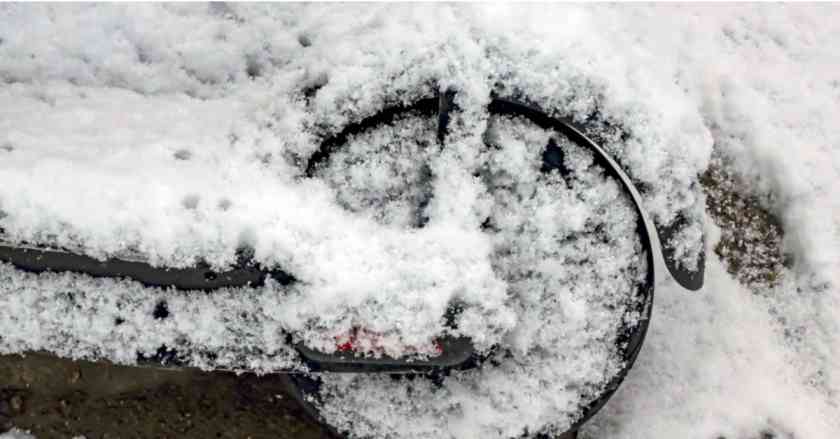
Preventing Damage from Winter Elements
Winter can be harsh on electric scooters, but with proper preparation and care, you can safeguard your ride from the elements. Here’s how to winterize your electric scooter against snow, ice, and moisture:
- Keep it Sheltered: Find a safe and sheltered spot to store your electric scooter during winter. If possible, keep it indoors, in a garage or shed. This will protect it from direct exposure to snow, ice, and freezing temperatures, which can lead to potential damage.
- Elevate the Scooter: If you’re storing your scooter on a concrete floor, consider elevating it slightly using wood or rubber blocks. This will prevent the cold from seeping into the tires and causing pressure-related issues.
- Use a Sturdy Cover: Invest in a high-quality, waterproof cover that fits your scooter snugly. A cover will shield your ride from snow, ice, and frost, preventing moisture from seeping into sensitive components.
- Tire Maintenance: Before storing your scooter, check the tire pressure and inflate them to the recommended level. Properly inflated tires will fare better against the cold and provide better performance when you’re ready to ride again.
- Anti-Corrosion Measures: Apply a thin layer of anti-corrosion spray to metal parts, such as handlebars, brake levers, and bolts. This will help protect them from rust and corrosion caused by exposure to snow, ice, and road salt.
- Dry Storage Area: Choose a dry storage area for your electric scooter during winter. Moisture can be detrimental to electrical components, so avoid leaving it in areas with high humidity or where water may drip on it.
- Silica Gel Packs: Place a few silica gel packs inside the storage area or under the scooter’s seat. These packs absorb moisture, reducing the risk of mold and mildew growth.
- Regular Check-ups: Perform regular check-ups on your stored scooter during the winter. Remove the cover and inspect the scooter for any signs of moisture or condensation. If you find any, wipe it away immediately and ensure the scooter is thoroughly dry before covering it again.
Essential Winter Storage Accessories for Electric Scooters
- Scooter Cover: A high-quality scooter cover is a must-have accessory for winter storage. Look for a cover specifically designed for electric scooters, ensuring a snug fit that shields your ride from moisture, dust, and debris. Waterproof covers with UV protection offer the best protection against the elements.
- Battery Tender/Charger: Investing in a battery tender or charger is essential for maintaining the health of your electric scooter’s battery during storage. These devices help keep the battery charged at an optimal level, preventing it from fully discharging or overcharging. Look for a battery tender with smart charging capabilities and automatic shutoff to ensure the battery remains in good condition.
- Moisture Absorbers: Moisture can be detrimental to your electric scooter’s components during winter storage. Consider using moisture-absorbing products such as silica gel packets or desiccant bags in the storage area. These absorb excess moisture, reducing the risk of corrosion and damage.
- Tire Pump: Keeping your scooter’s tires properly inflated is crucial, even during storage. A compact and portable tire pump allows you to maintain the recommended tire pressure. Look for a pump that is compatible with the valve type on your scooter’s tires.
- Lock or Security System: While not directly related to winterization, a lock or security system is an important accessory to protect your electric scooter from theft, even during storage. Opt for a sturdy lock or a reliable security system to provide peace of mind.
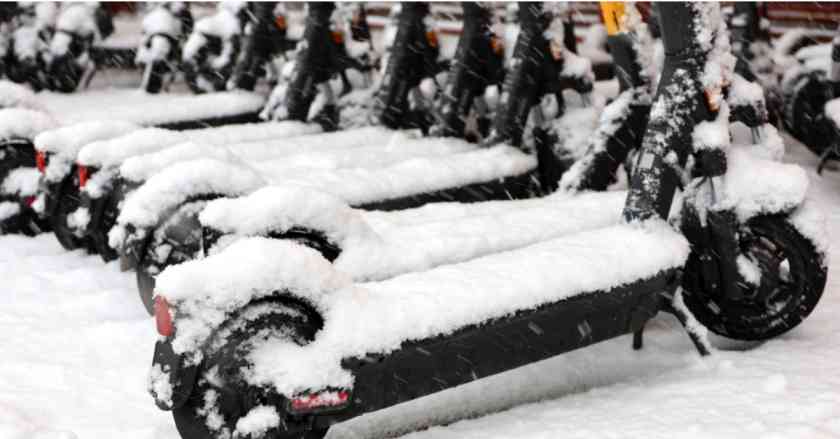
Don’t Ride in Harsh Winter Conditions
When it comes to storing your electric scooter during winter, it’s crucial to prioritize safety and make wise decisions. While electric scooters are a convenient mode of transportation, it’s important to exercise caution and avoid riding in harsh winter conditions.
As the snow falls and ice coats the streets, it’s best to leave your scooter safely stored until the weather improves. Riding in extreme winter conditions increases the risk of accidents, loss of control, and damage to your scooter.
Instead, patiently wait for milder weather to enjoy your scooter’s smooth and enjoyable ride. Remember, safety always comes first, and preserving your scooter’s longevity is equally important.
Preparing for the First Ride of Spring
Uncovering Your Electric Scooter – As you remove the winter cover, your electric scooter emerges in pristine condition, like a hidden treasure finally uncovered. With a careful eye, you inspect every detail for signs of wear or damage, but your ride seems to have weathered the winter just fine.
Battery Care and Maintenance – Reconnect the battery following the manufacturer’s instructions, and let it bask in the power of life. Check the battery charge, and if it’s running low, plug your scooter into a reliable power source. Test its performance, making sure all electrical functions dance to life.
Tire Inspection and Maintenance – First, examine the tire pressure using a gauge and adjust it to the recommended PSI for peak performance and safety. Next, evaluate the tread depth; worn-out tires affect traction and handling, so replace them if necessary. Lastly, inspect the tires for cracks or damage, as these issues can compromise safety, requiring immediate replacement if found.
Mechanical Checks and Adjustments – Start with testing the brakes, both front and rear, for smooth engagement and sufficient stopping power. Next, examine the suspension and steering for wear, looseness, or excessive play to ensure a comfortable and controlled ride. Finally, test all lights and signals, including headlights, taillights, turn signals, and brake lights, replacing any faulty or dim bulbs.
Final Touches – Lubricate moving parts like the chain, hinges, and pivots to reduce friction and prevent rust. Check your reflective gear and replace any worn-out items for better visibility and safety. Lastly, plan your first ride of the season, but remember to adhere to local regulations and wear proper safety equipment like a helmet.

Frequently Asked Questions (FAQs)
Why is winter storage important for electric scooters?
Winter storage is essential for electric scooters because the cold weather and harsh elements can cause damage to the scooter’s components, battery, and overall performance.
Can I leave my electric scooter outside during winter?
Extreme cold, snow, and moisture can lead to corrosion, battery issues, and damage to various parts of the scooter. It’s best to store your scooter indoors or in a covered space to protect it from the elements.
Should I remove the battery during winter storage?
If possible, it’s advisable to remove the battery from your electric scooter during winter storage. Storing the battery separately in a cool, dry place helps prevent freezing and maintains its health. If you cannot remove the battery, keep it fully charged and use a battery tender to hold its charge.
How often should I check my electric scooter during winter storage?
It’s a good idea to conduct monthly check-ups on your electric scooter during winter storage. Inspect the scooter for any signs of pests, mold, or mildew. Check the battery charge level and top it up if necessary. Regular checks ensure any issues are addressed promptly.
Do I need to lubricate my electric scooter before storage?
Yes, lubricating certain parts of your electric scooter before storage can help prevent rust and ensure smooth operation when you take it out again. Lubricate the chain, brake cables, and other moving parts using appropriate lubricants.
Can I ride my electric scooter in light snow or cold weather?
While electric scooters can handle light snow or cold weather, it’s best to avoid riding them in such conditions whenever possible. Snow and icy surfaces can reduce traction and pose safety risks.
Is it necessary to elevate the scooter during winter storage?
Elevating the scooter slightly during storage is beneficial if you’re storing it on a concrete floor. Using wood or rubber blocks to raise the scooter prevents the tires from absorbing cold from the floor, affecting tire pressure and performance.
Can I use a regular cover for my electric scooter?
While a regular cover may provide some protection, it’s better to use a cover specifically designed for electric scooters. Electric scooter covers are tailored to fit the scooter’s dimensions and offer better protection against moisture, dust, and debris.
How can I protect my electric scooter from theft during winter storage?
To protect your electric scooter from theft during storage, use a high-quality lock or security system. A sturdy lock or an alarm system will deter potential thieves and add an extra layer of security.
Can I store my electric scooter on its kickstand during winter?
Storing your electric scooter on its kickstand for an extended period can cause the tires to develop flat spots. It’s better to use a center stand or elevate the scooter to avoid potential tire damage.
Conclusion:
Learning how to store electric scooter in winter is a vital responsibility for all scooter owners. By following the proper steps, you can protect your valuable ride from potential damage caused by cold weather and moisture.
Proper battery care, sheltered storage, and maintenance checks throughout winter will ensure your electric scooter is ready to provide you with many more enjoyable rides when spring finally arrives.
So, take the time to show your electric scooter some love and care during the winter months, and it will reward you with a smooth and exhilarating ride when the sun starts shining again. Stay safe, and happy scooting!



